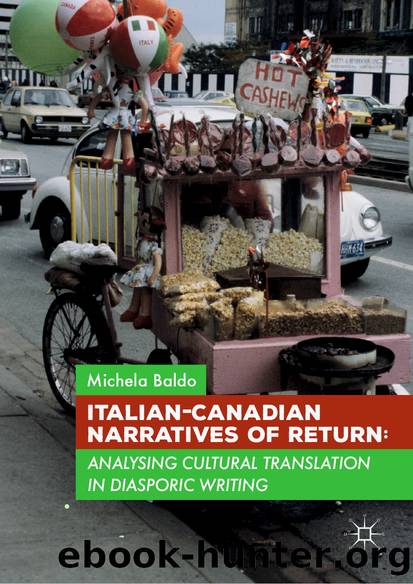Italian-Canadian Narratives of Return by Michela Baldo

Author:Michela Baldo
Language: eng
Format: epub
ISBN: 9781137477330
Publisher: Palgrave Macmillan UK
4.2 Code-Switching and Return in Nino Ricciâs Trilogy and Its Italian Translation
4.2.1 Code-Switching in Nino Ricciâs Trilogy
I provide here an overview of code-switching in Nino Ricciâs trilogy (1990, 1993, 1997), drawing on Camarcaâs (2005) study and on my own research (see Baldo 2008). 7
Code-switching in Nino Ricciâs trilogy (see also Appendices A and B) involves the following languages: Canadian English (the main language of narration), closer to North American English than British English (Concilio 2003), 8 standard Italian, italiese/Italo-Canadian loanwords (although sporadically), a variety of a Molisan dialect, French, Spanish and German (very sporadic cases). Italiese/Italo-Canadian loanwords (English borrowings inserted into an Italian dialect base) in Ricciâs trilogy are typically assigned a gender through the addition of an article or a final Italian or dialect vowel; they are nativised (Clivio and Danesi 2000), as in la ghellafriend and lu boss, made by the English loanwords girlfriend and boss inserted into a Italian dialect matrix language.
Along with italiese/Italo-Canadian, the trilogy also features the use of a dialect (or a variety of dialects) from the Molise region, which is used in the speech of characters from the Molisan village of Valle del Sole and nearby villages both in Italy and in Canada where these immigrants have settled. Nino Ricci states 9 that the dialect used in the trilogy is the transcription, based on personal memories, of the dialect of his parents, who are from two villages in the province of Isernia, Villacanale and Poggio Sannita, and of his relatives from the same or nearby villages. Moreover, he says in an interview (Ricci 2018, see Appendix G1) that âit was hard to research proper spellings and vocabulary, particularly given that dialects often shifted even from one town to the nextâ.
The Molisan dialects belong to the group of Central/Southern Italian dialects, specifically to the subgroup of southern intermediate dialects, along with dialects from the Italian regions of Abruzzi, Puglia (the Northern part), Campania and Basilicata (Coveri et al. 1992; Hastings 1997).
With regard to the number or frequency of switches in Ricciâs trilogy (see Camarca 2005; Baldo 2008), a substantial amount of code-switching occurs in direct speech. Nino Ricciâs characters speak Italian and Italian dialects since the novel is set in Italy, and so code-switching, in this particular case, is prompted by the setting. However, the use of code-switching in direct speech is restricted to a small group of formulaic expressions, and only the most stereotypical expressions of oral conversation are involved; for example, greetings such as addio (goodbye), buongiorno (good morning), buona fortuna (good luck); exclamations (invocations and swear words) such as Gesú Cristâ e Maria (Jesus Christ and The Virgin Mary), stronzo/a (asshole); and discourse markers, such as mbeh, bene (well). The reason for this is not only that these categories are the standard components of oral conversation, but that the authorâs use of code-switching is constrained because of his Anglophone readershipâs limited linguistic competence in Italian or Southern Italian dialects, as already stated. The mimetic intent is thus subservient, in Ricciâs novels
Download
This site does not store any files on its server. We only index and link to content provided by other sites. Please contact the content providers to delete copyright contents if any and email us, we'll remove relevant links or contents immediately.
| Anthropology | Archaeology |
| Philosophy | Politics & Government |
| Social Sciences | Sociology |
| Women's Studies |
Born to Run: by Christopher McDougall(7064)
The Leavers by Lisa Ko(6910)
iGen by Jean M. Twenge(5366)
Sapiens by Yuval Noah Harari(5293)
The Kite Runner by Khaled Hosseini(5081)
Spare by Prince Harry The Duke of Sussex(5071)
Machine Learning at Scale with H2O by Gregory Keys | David Whiting(4167)
Bullshit Jobs by David Graeber(4094)
Never by Ken Follett(3787)
Goodbye Paradise(3724)
Livewired by David Eagleman(3682)
Fairy Tale by Stephen King(3216)
A Dictionary of Sociology by Unknown(3016)
Harry Potter 4 - Harry Potter and The Goblet of Fire by J.K.Rowling(2984)
The Social Psychology of Inequality by Unknown(2936)
The Club by A.L. Brooks(2862)
Will by Will Smith(2788)
0041152001443424520 .pdf by Unknown(2783)
People of the Earth: An Introduction to World Prehistory by Dr. Brian Fagan & Nadia Durrani(2700)
